Wood bees, also known as carpenter bees, can be a nuisance for homeowners, as they burrow into wooden structures to build their nests. While these bees are beneficial pollinators, their presence can lead to structural damage and unsightly holes in wood surfaces. Getting rid of wood bees requires a combination of preventative measures and targeted treatments to deter them from nesting and eliminate existing infestations.
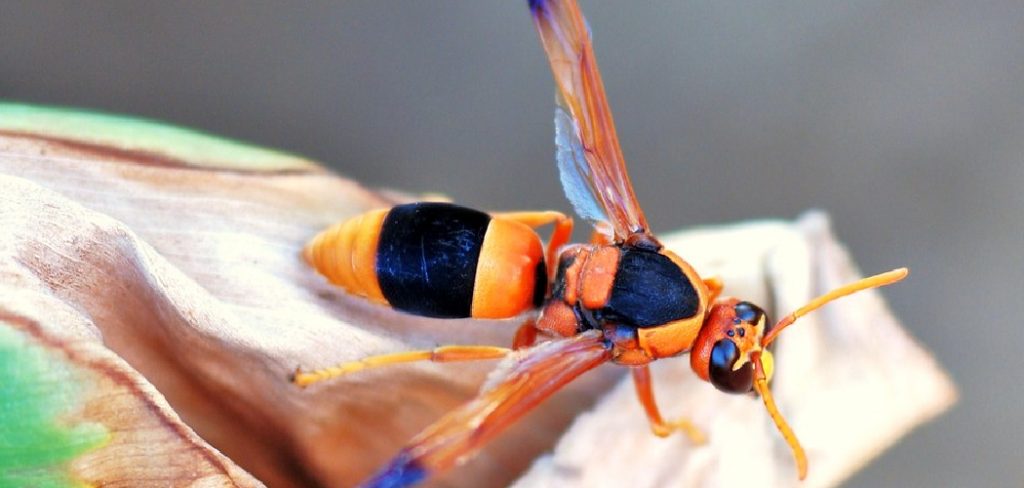
From sealing potential entry points to using insecticidal sprays and traps, there are various strategies homeowners can employ to effectively control wood bee populations and protect their property. In this article, we will explore various methods for how to get rid of wood bees, providing practical tips and advice for homeowners facing this common pest problem.
Importance of Addressing Wood Bee Infestations
Addressing wood bee infestations in a timely manner is crucial for several reasons. Firstly, the burrowing activity of carpenter bees can weaken wooden structures over time, leading to costly repairs and potential safety hazards. If left unchecked, the tunnels created by these bees can become extensive, compromising the integrity of decks, eaves, siding, and other wooden elements.
Secondly, the presence of wood bees can attract woodpeckers, which peck at the wood to feed on bee larvae, exacerbating the damage. Furthermore, wood bees can re-infest the same areas year after year if not properly managed, making it essential to implement effective preventative and control measures.
What Are Wood Bees?
Wood bees, commonly known as carpenter bees, belong to the genus Xylocopa. They are named for their unique ability to burrow into wood to create their nests. Unlike termites, wood bees do not consume wood; instead, they excavate tunnels to lay their eggs and rear their young.
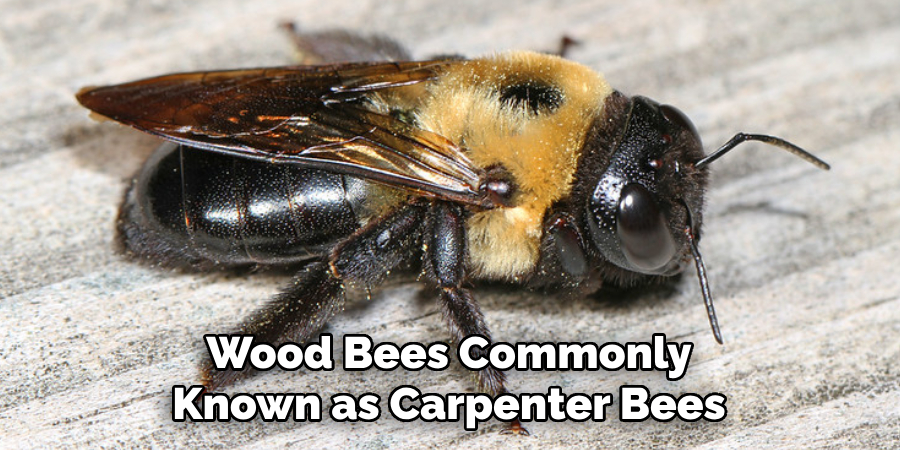
Carpenter bees are often mistaken for bumblebees due to their similar size and appearance, but they can be distinguished by their shiny, black abdomen, which lacks the fuzziness characteristic of bumblebees. There are two primary types of carpenter bees: small carpenter bees and large carpenter bees, with the latter being more common and typically more destructive to wooden structures.
Lifecycle and Behavior of Wood Bees
Understanding the lifecycle and behavior of wood bees is essential for effectively managing and preventing infestations. The lifecycle of a wood bee begins in the spring when adult bees emerge from hibernation.
Males typically emerge first and establish territories, while females search for suitable wooden structures to create nesting sites. The female carpenter bee uses her strong mandibles to bore into wood, forming a tunnel where she will lay her eggs. Each tunnel consists of several individual brood cells, separated by partitions made of chewed wood pulp.
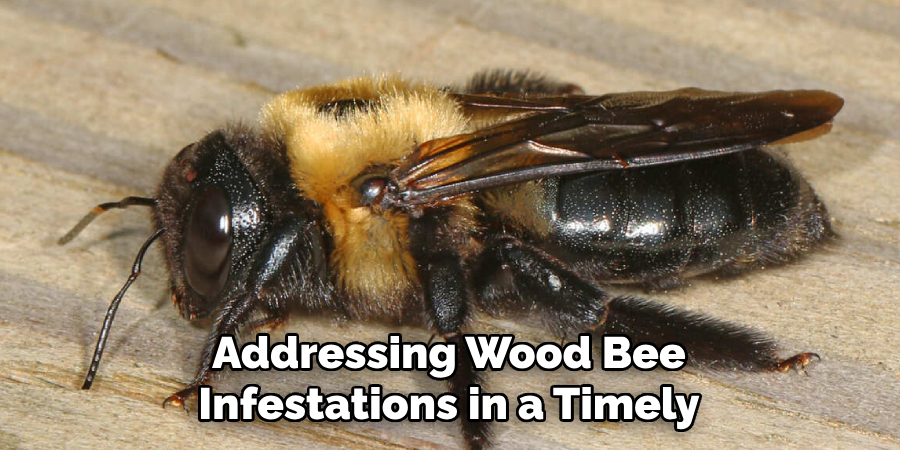
Once the nesting site is prepared, the female lays an egg in each cell, provisions it with a mixture of pollen and nectar, and seals the cell with a plug of wood. The eggs hatch into larvae, which feed on the provided food supply and eventually pupate. After pupation, new adult bees emerge from the brood cells, completing the lifecycle. This process typically takes several weeks, with new adults emerging in late summer or early fall.
10 Methods How to Get Rid of Wood Bees
1. Identifying Wood Bee Activity
The first step in getting rid of wood bees is identifying their activity. Look for round, half-inch diameter holes in wooden surfaces, often located under eaves, decks, or wooden furniture. You may also notice piles of sawdust or pollen near these holes, indicating recent bee activity. Additionally, observe the bees themselves; carpenter bees are large, robust insects with shiny black abdomens and may be seen hovering around wooden structures or entering and exiting holes.
2. Sealing Entry Points
Prevent wood bees from nesting in your home or property by sealing potential entry points. Inspect wooden surfaces for cracks, gaps, or unfinished edges where bees may gain access. Use caulk or wood putty to fill in these gaps and seal cracks, ensuring a tight seal that prevents bees from burrowing into the wood. Pay particular attention to areas where wood meets other materials, such as siding or trim, as these junctions are common entry points for wood bees.
3. Applying Insecticidal Dust
Insecticidal dust can be an effective method for controlling wood bees and eliminating existing infestations. Apply a dust formulated specifically for carpenter bees directly into the entrance holes using a duster or puffer applicator. The dust will penetrate deep into the tunnels, killing adult bees and larvae. Be sure to wear protective clothing, gloves, and a mask when applying insecticidal dust, and follow the manufacturer’s instructions carefully to ensure safe and effective application.
4. Using Liquid Insecticides
Liquid insecticides can also be effective for treating wood bee infestations, especially for large or hard-to-reach nests. Choose a liquid insecticide labeled for carpenter bees and mix it according to the manufacturer’s instructions. Apply the insecticide directly into the entrance holes using a sprayer or injector, saturating the tunnels thoroughly. Liquid insecticides typically contain residual ingredients that can provide ongoing protection against wood bees and other pests.
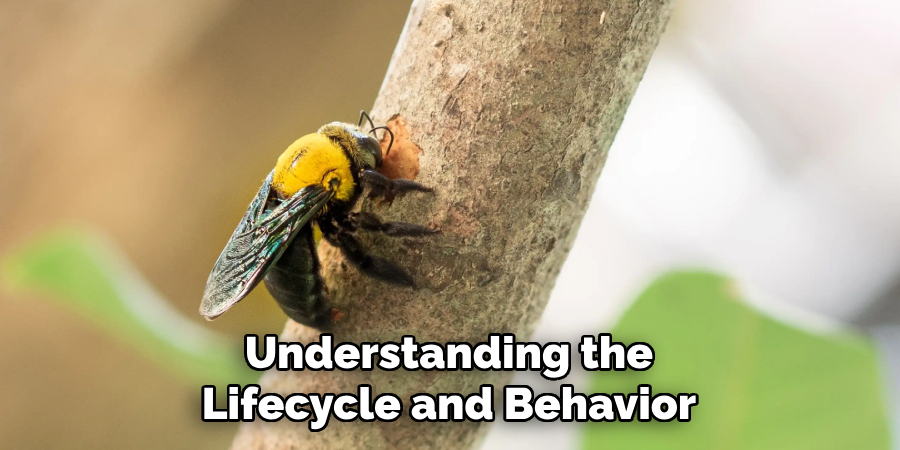
5. Installing Wood Bee Traps
Wood bee traps are passive devices designed to attract and capture wood bees, reducing their numbers and preventing further damage. These traps typically consist of wooden or plastic housing with a collection jar or bag attached to catch trapped bees. Hang traps near areas of high bee activity, such as eaves or decks, using the included hooks or mounting hardware. Some traps use attractants such as pheromones or floral scents to lure bees inside, while others rely on visual cues to attract bees.
6. Applying Natural Repellents
Natural repellents can be an environmentally friendly alternative for deterring wood bees from nesting in your home or property. Essential oils such as citronella, peppermint, or eucalyptus are known to repel bees and can be applied to wooden surfaces using a spray bottle or cloth. Alternatively, plant bee-repelling herbs and flowers around your home, such as lavender, mint, or marigolds, to create a natural barrier against wood bees. While natural repellents may not provide immediate results, they can be a long-term solution for preventing wood bee infestations.
7. Painting or Staining Wooden Surfaces
Protect wooden surfaces from wood bee damage by painting or staining them with a protective finish. Bees are less likely to burrow into sealed or treated wood, as the finish creates a barrier that prevents them from accessing the soft inner layers. Choose a high-quality paint or stain specifically formulated for outdoor use and apply multiple coats to ensure thorough coverage. Be sure to pay attention to areas prone to bee activity, such as eaves, decks, and outdoor furniture, and reapply the finish as needed to maintain protection.
8. Installing Screen or Wire Mesh
Prevent wood bees from accessing vulnerable areas of your home or property by installing screen or wire mesh over openings and vents. Use a fine mesh with small openings to keep bees out while allowing for adequate airflow. Secure the mesh tightly to the opening using screws or nails, ensuring a tight seal that prevents bees from squeezing through gaps. This method is particularly effective for covering attic vents, crawl space openings, and other large openings where bees may enter.
9. Removing Infested Wood
If you have severe wood bee infestations or damage, consider removing and replacing infested wood to eliminate the source of the problem. This may involve replacing damaged siding, eaves, or decks with new, untreated wood or alternative materials such as vinyl or composite. Be sure to seal or treat the new wood to prevent future infestations. If the infestation has spread to structural components of your home, such as beams or joists, consult a professional contractor or pest control specialist for assistance with removal and replacement.
10. Consulting a Pest Control Professional
If you have persistent wood bee infestations or are unsure how to effectively control them, consider consulting a pest control professional for assistance. Pest control experts have the knowledge, experience, and equipment necessary to identify and treat wood bee infestations safely and effectively.
They can assess the extent of the infestation, recommend appropriate treatment methods, and provide ongoing monitoring and maintenance to prevent future problems. Additionally, pest control professionals can offer advice on preventing wood bees and other pests from returning to your home or property.
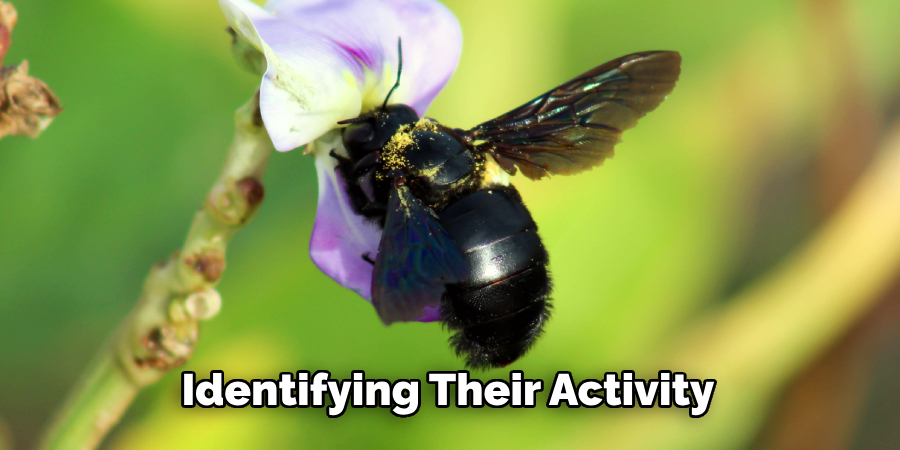
Conclusion
Wood bees can be a persistent pest problem for homeowners, but with the right techniques and strategies, you can effectively control their populations and protect your property from damage. From sealing entry points and applying insecticides to installing traps and consulting pest control professionals, there are numerous methods available for getting rid of wood bees.
By following these ten effective methods and taking proactive steps to prevent infestations, you can keep your home and property free from wood bee damage and enjoy peace of mind knowing that your wooden structures are protected. Thanks for reading our blog post on how to get rid of wood bees! We hope you found it helpful and informative.
About the Author
Adrian Green, a lifelong woodworking enthusiast, shares his passion for the craft through The Woodenify Blog. With a foundation built on years of hands-on experience in his father’s woodworking shop, Adrian is dedicated to helping others learn and grow in the world of DIY woodworking. His approach to woodworking combines creativity, practicality, and a deep appreciation for the art of building with your own hands. Through his blog, he inspires individuals of all skill levels to embark on their own woodworking journeys, creating beautiful, functional pieces of furniture and décor.
Professional Focus
- Specializes in DIY woodworking projects, from furniture to home décor.
- Provides step-by-step guides and practical tutorials for woodworkers of all skill levels.
- Dedicated to helping readers build confidence and skill through easy-to-follow instructions and tips.
- Passionate about fostering a community of makers who can share, learn, and grow together.
Education History
- University of Craft and Design – Bachelor of Fine Arts (BFA) in Woodworking and Furniture Design
- Woodworking Apprenticeships – Extensive hands-on training with skilled craftsmen to refine carpentry and furniture making techniques.
- Online Courses & Masterclasses – Continued education in advanced woodworking techniques, design principles, and specialized tools
Expertise:
- DIY woodworking, carpentry, furniture making, and home décor projects.
- Creating accessible tutorials and guides for beginner to advanced woodworkers.
- Sharing the joys and satisfaction of woodworking, from raw materials to finished products.
